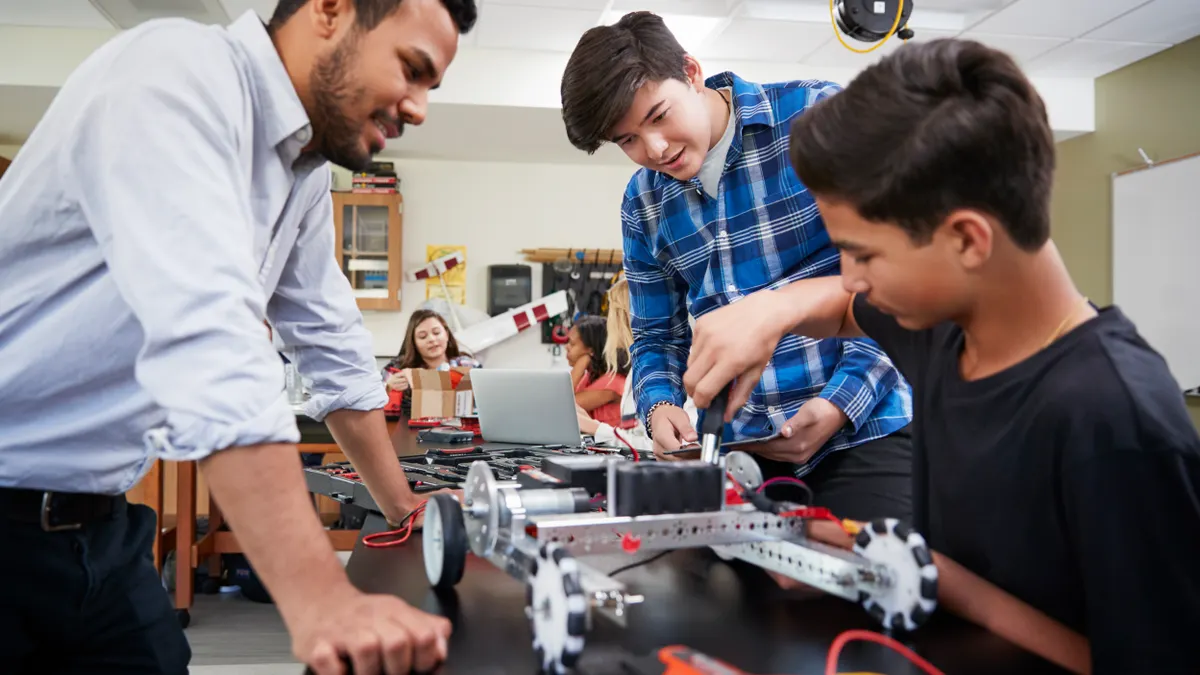This is the latest installment in Curricular Counsel, an ongoing series of conversations with district chief academic officers and similar administrators about their best practices and biggest challenges in resource adoption, standards alignment and more.
One of the top curriculum trends in recent years doesn't involve resources and material themselves, but rather the space in which learning occurs — shifting from post-industrial rows of desks with a teacher in front talking at students to a more free-form model that inspires creativity rather than compliance.
For Robert "Bob" Dillon, the director of innovative learning for the School District of University City in Missouri, that shift requires teachers to transition from a "decorator" to a "designer" mindset. After taking on the position four years ago, Dillon set out to find what systems in schools were inefficient for students and teachers, and where friction existed.
"It became clear that one of those elements was how classroom design was stuck, as a system," he told Education Dive. "We ordered furniture the same way, we made decisions the same way, we didn't talk to the kids about what we wanted to do — all of those things were getting in the way of us changing the way learning happened."
Reimagining classrooms was also an easy task to get teachers on board with quickly, he said, "because they like the idea of having new things, they liked the idea of having different options in their classrooms."
Dillon, who also co-authored "The Space: A Guide for Educators," shared how educators can get started with a classroom redesign and what his favorite new approaches have accomplished.
This interview has been edited for brevity and clarity.
EDUCATION DIVE: When you're redesigning a learning space, how closely are you working with the district's academic office to figure out how leaders are rethinking curriculum for that space?
ROBERT DILLON: I think one of my unique roles as a director of innovative learning is to be a conduit between the curriculum instruction office, the technology department, the operations department and the communications office. My role impacts all four of those areas, so I got lucky that my position really got to bring some synergy between those four areas. I think sometimes we forget that the communications office and how we talk about this with parents and the community makes a ton of difference, as well.
Are there any particularly interesting approaches to curriculum that you've seen made possible in any of the learning spaces you've redesigned?
DILLON: One of them is this ability to unleash the entrepreneurial spirit. We've seen it in a couple of different school districts where I've worked, where we've launched a program to give kids an opportunity to start a small business, to take the things they're passionate about and monetize them.
I also think that's solving real-world problems. You can call that problem-based learning or project-based learning. I think in University City, we're really focused on kids engaging in the problems that exist in their communities, taking on the role of social justice advocate and change aid.
That's a pretty unique thing for schools to do, and we're really giving kids space and time to do that with the redesigns.
Given that the reasons for and the approaches to redesigning the learning space are probably going to vary, what are some of the first steps educators should consider across the board for any sort of redesign?
DILLON: First and foremost, getting feedback from students on what is currently working for them and what currently isn't working for them. I don't think we [as educators] do that very often.
Also start in the realm of addition by subtraction — so many classrooms have accumulated so much stuff that it's really hard for [educators] to envision what the next iteration is. What can we start to get rid of? What can we start to eliminate from classrooms that isn't serving anyone?
The cool part about both of those things is that they're free and anyone can kind of start doing those things.
I would just say the third is starting to tinker and experiment. That could mean trying some different configurations of seating, that could be letting kids stand and move in the back of the room. But [it's about] just breaking the inertia of what you are doing and what the routine looks like right now.
In what ways do you also reconsider approaches to professional development to help prepare teachers to make the most of their redesigned spaces?
DILLON: Allowing professional development to happen in redesigned spaces gives teachers a feel and energy for what's possible in those spaces. We try to make sure teachers are in new, modern spaces when they're doing their teacher learning.
But then we also make sure we're providing professional development around things like how to talk about new spaces with kids or how to build a student-centric environment. We're having questions and conversations about those two items in professional development where we may not have to that depth before.






 Dive Awards
Dive Awards
















